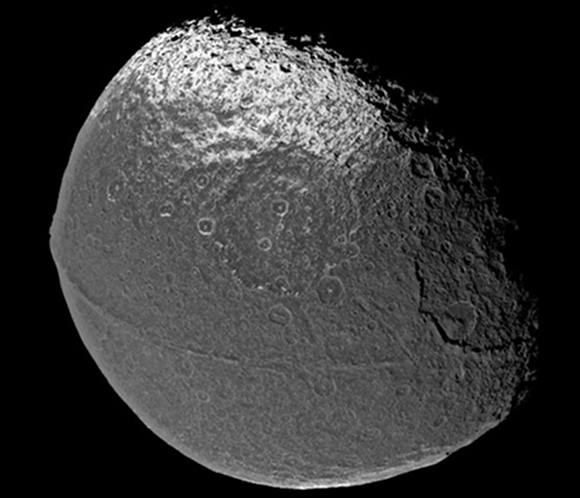This article is more than 1 year old
Boffins puzzled over impossibly fast ice avalanches on Saturn's moon
Is all that rubbing making ice rubble hot?
Planetary boffins have spotted that Saturn's other moon, the walnut-shaped Iapetus, is home to spectacular ice avalanches that flow across the surface of the rock.

The walnut in the sky. Credit:NASA/JPL/SSI
The ridge of 20km-high mountains, twice the height of Mount Everest, that circle the equator of the moon and give it its walnutesque appearance are the starting point for the ice-slides. The mountainous heights and the deep giant impact basins make for good conditions to get up a bit of speed when the ice gives way. What's strange is that at some point, the coefficient of friction drops and the slide flows instead of tumbling, allowing the ice to go much further.
Earth and Mars both have a similar phenomenon in so-called long-runout landslides or sturzstrom. Instead of travelling the typical horizontal distance of something less than twice what they've fallen, the rocks flow on for 20 or 30 times farther than the first fall, sometimes even managing to surge uphill.
What should be happening is that the rockslide tumbles until the friction between the debris and the ground uses up all the energy the rocks got from falling, stopping the slide in its tracks. Instead, the sturzstrom flow across the ground like a fluid river, something boffins have trouble explaining.
Scientists have posited some sort cushion of air, water or even powdered rock under the slide that helps lubricate it into a flow.
"The landslides on Iapetus are a planet-scale experiment that we cannot do in a laboratory or observe on Earth," Kelsi Singer, a graduate student in earth and planetary sciences at Washington University in St Louis, said. "They give us examples of giant landslides in ice, instead of rock, with a different gravity, and no atmosphere. So any theory of long runout landslides on Earth must also work for avalanches on Iapetus."
Singer spotted the icy avalanches by studying images from the Cassini spacecraft, but the pictures don't give much clues about what's causing the massive slides.
The researchers think that it may be sheer speed that cuts the friction for the ice, in the same way that major faults can slip off each other during an earthquake – resulting in "localized frictional heating in [the] ice rubble".
"If you had some kind of quick movement, whether it was a landslide or the slip along a fault, the same kind of thing could happen," Singer says. ®
The paper was published in Nature Geoscience yesterday.
